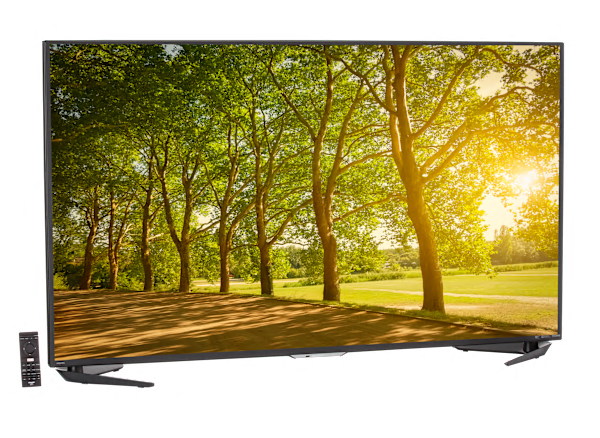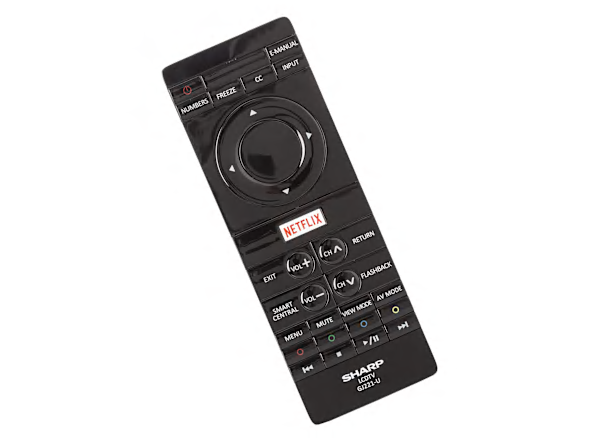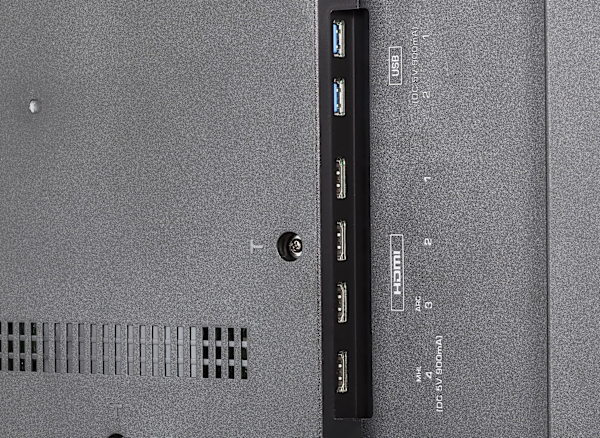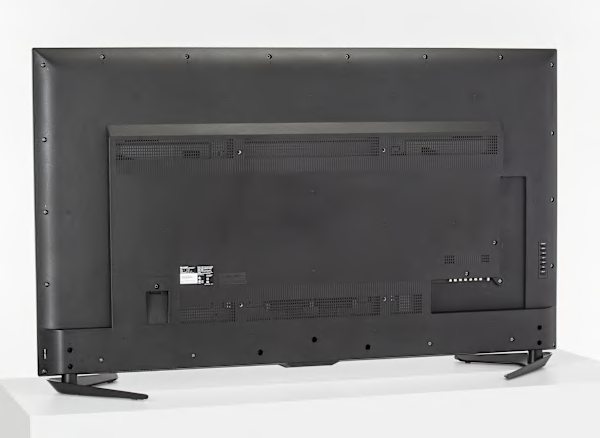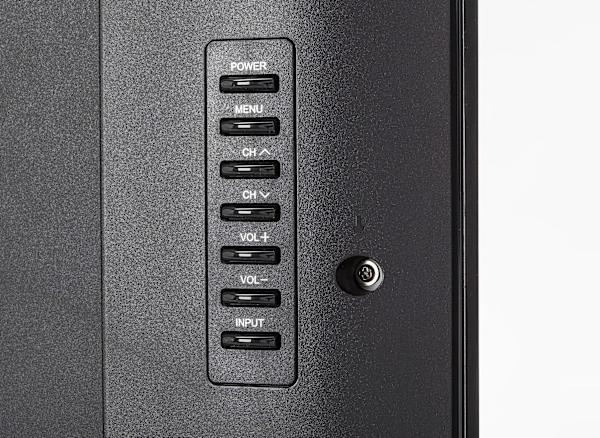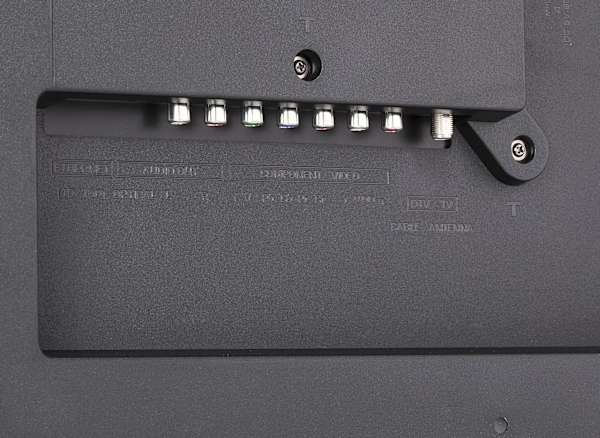PICTURE QUALITY This model had very good high-definition picture quality. It generally did an excellent job displaying the finest detail, but a bit of added edge-enhancement was also noted which we could not minimize this with the picture controls. Color accuracy was very good, with images generally looking natural, though color temperature was slightly on the cool side, with images tending a touch toward blue. . Contrast--the difference between the darkest blacks and brightest whites--was good, so images had depth and dimension, typical of most models we test. The brightness level was good, making it a suitable choice for most rooms. Black levels are very good, delivering fairly deep blacks due to Sharp's effective "AquoDimming," a local dimming feature designed to give greater depth and contrast to dark scenes. Any unwanted illumination side effects often introduced by such a feature were minimal so we left the feature on. With the feature off, black levels were still acceptable. (see "viewing angle" comments for other limitations on black level quality.) In scenes with subtly shaded light-to-dark areas, such as a sky during sunset, the TV did a very good job producing a smooth transition without distinct, coarse bands. There was slight display nonuniformity that created brighter cloudy areas most noticeable on very dark scenes (or in the black bars of a letterboxed movie). We routinely see this issue with LCDs and severity can vary from TV to TV. Check your model for this issue, and if present, see if you find it distracting. The deinterlacing and film mode operations were excellent on HD content; there was little or no trace of jaggies on the edges of objects for video and film-based 1080i video content, such as from cable.
VIEWING ANGLE This Sharp has a moderate viewing angle overall, decent, but not quite as good as the better-performing LCD sets we've tested. The optimal seating position for best picture quality is directly in front of the TV. If your family is seated in chairs off to the side of the TV, they'll see decent but compromised image quality.
When we moved off to the sides the horizontal viewing angle was good; the picture showed a slight loss of color, along with a moderate color shift. Black levels visibly brightened, reducing contrast. When viewing the image from above or below eye level to the screen, the vertical viewing angle was very good. The picture showed minimal change in color, contrast, and black level.
ULTRA HD PERFORMANCE This Sharp UHD TV delivers excellent 4K picture detail and very good HD-to-UHD upconversion, but flawed processing in streaming and photo modes limits overall UHD performance. All native 4K content we played on this model, including movies and test videos from our Sony FMPX10 player, was presented in full 4K detail with excellent fidelity when played back via the TV's HDMI input. This model also supports video streaming of 4K programs via both Netflix and YouTube (among other emerging sources), with generally finely detailed 4K images but we also noted that a motion smoothing feature was active which could not be turned off. Also referred to as a "soap-opera-effect," motion smoothing removes the natural judder (or jerky motion) that is normal for films shot at 24Hz. If you plan on streaming 4K and you're not crazy about this effect, this could be a deal breaker. No picture controls other than a picture mode selection are available while streaming. We chose the Movie mode. Using the TV's USB port, we were able to play back 4K videos stored on a flash drive which were encoded in the HEVC, MP4, and VP9 test file formats. With photo play back, high resolution images were unfortunately downscaled to lower 1080p resolution, not taking advantage of the display's detail potential. With regular HD content, the TV's HD-to-UHD up-conversion processing was very good, with edges along diagonals of image content showing slight jaggies, just short of the best we've seen. We also noted that moderate edge enhancement was applied to HD picture that we didn't see with 4K content. All four of the TV's HDMI inputs comply with the latest HDMI 2.0 and HDCP 2.2 specifications that support play back for 4K video at 60Hz, and copy protection, a requirement for compatibility with emerging 4K movie play back devices such as a 4K Blu-ray player.
MOTION BLUR This Sharp TV has only fair motion performance, with significant blurring on our motion tests. While this model's Motion Enhancement feature does significantly reduce motion blur, it also activates a smooth-motion effect that removes film judder (the slightly jerky motion visible during camera pans on film-based content), giving movies a video-like appearance that some may not prefer. We turned the feature off. On typical program content, the blurring effect is often fleeting and may not bother most people. However, keen-eyed viewers may detect the loss of texture and detail on scenes with movement, especially in high-quality video such as a Blu-ray movie.
SCREEN REFLECTIVITY Though not as mirror-like as on some LCDs, this screen surface is glossy and therefore susceptible to reflections from a nearby lamp or window. The screen is dark so it does a good job reducing glare from ambient light and maintains contrast even in a bright room.
SOUND QUALITY This TV has good sound quality; about average among the TVs we've tested. When watching a movie blockbuster, a concert, or TV show, it delivers decent performance but falls short of the better performers. With movies, dialog was generally clear sounding, though somewhat muffled, and overall a bit recessed with respect to background music and other sounds. Bass extension was decent, though a tad boomy, which added some fullness to the sound, and treble was nicely detailed, while the overall sound was on the bright side, and somewhat closed in. It has a good volume range so the TV should play sufficiently loud in typical room environments. Also, at higher volume settings audible dynamic compression keeps the sound from distorting but also limits clarity when there are peaks in loudness, which can be distracting on some audio content. Most will find this sound quality acceptable.
EASE OF USE Overall, we found the set easy to use. Setting up the TV for the first time was straightforward, as was access to features and controls you'll probably adjust only once. Ease of access to features you typically use more often was very good. Also, the remote is satisfactory, and the on-screen menu is easy to navigate.
The black against black labeling of the connectors on the TV console is very difficult to read. It lacks the ability to add custom labels to different input sources.
STAND ASSEMBLY Mounting the support stand to the TV is straightforward. The TV's stand extends to the far ends of the display, which means the table top you'll be setting the TV on will need to be at least as wide as the display itself.
INTERNET FEATURES This TV provides basic Internet functionality with a limited selection of applications Movie streaming services include: Netflix, Vudu, YouTube, Pandora.
CONNECTIONS This TV includes four HDMI inputs, one shared connection between the component and composite inputs (which means you can only use one type or the other at a time), optical digital audio out, two USB ports, an Ethernet port, and Wi-Fi. Wireless connectivity includes: DLNA network file sharing. The cable connections on the rear panel are recessed with side or bottom-facing ports, so wires don't protrude beyond the display's depth.
INCLUDED IN THE BOX The TV comes with: an electronic user manual accessible via the TV's menu (no printed manual is included), a quick start guide, a remote with batteries, provided cables (HDMI cable), and USB IR blaster. Bag is marked for USB cable but has a COMCAST HDMI cable inside.. ABOUT FIRMWARE VERSION: Our test results and picture settings are valid for the version of firmware indicated. If your TV's firmware differs from the one shown you either have an older or a newer version of firmware. Manufacturers may periodically upgrade the TV's firmware to enhance operation, fix bugs, or add features. Firmware upgrades may be downloadable directly to your TV via a wired or wireless network (if internet capable), USB port, or memory card, depending on your TV's capability. You can check your TV's firmware version, or upgrade to the latest firmware by pressing the menu button on your remote and navigating to the appropriate submenu, typically under settings. Consult the user manual or manufacturer's website if further guidance is needed.

















